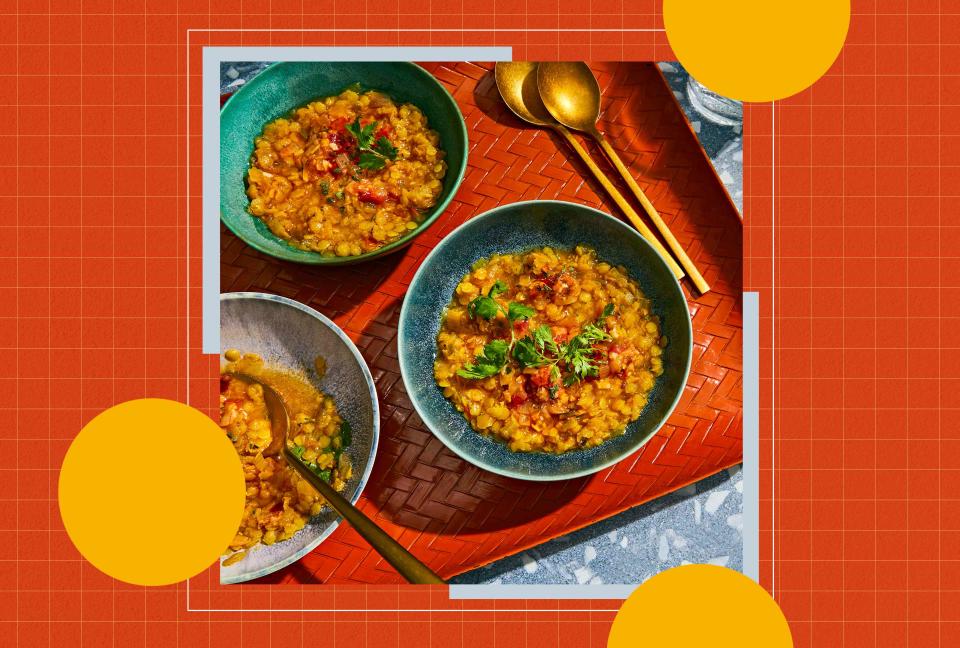I’m a Lifelong Vegetarian—These 8 High-Protein Foods Are Always In My Shopping Cart
They're nutritious, versatile and have plenty of staying power.

Jenny Huang
Reviewed by Dietitian Annie Nguyen, M.A., RD
As a cookbook author and lifelong vegetarian who eats a moderately low-carb diet, I prioritize protein on my plate at every meal. In combination with fiber and healthy fats, protein makes my meals satisfying by balancing my blood sugar, keeping me full for longer and reducing cravings. I aim to get 20 to 30 grams of protein with every meal. While this is certainly possible, I find that making sure my kitchen is well-stocked with a variety of protein sources keeps my meals exciting. Here are eight of my favorite vegetarian proteins that are always in my shopping cart.
1. Greek-Style Yogurt & Cottage Cheese
If you eat dairy, Greek-style yogurt and cottage cheese can deliver the biggest bang for your buck. In a scant ½-cup serving, Greek-style yogurt delivers 9 to 10 grams of protein, and cottage cheese 11 to 12 grams. I use Greek-style instead of regular yogurt to make Indian dishes like raita, and it's great in salad dressings too. Cottage cheese is certainly having its moment right now, probably because of its versatility. You can use it to make everything from pasta sauce to ice cream!
Related: The 4 Best Cottage Cheese Brands, Tested by EatingWell Dietitians & Editors
2. Extra-Firm Tofu & Edamame
Soy is a go-to in my plant-based-protein pantry because products made from soybeans like tofu and edamame are complete proteins, containing all nine essential amino acids. I like to have a batch of air-fried tofu on hand to toss in salads or use to make grain bowls. I also enjoy grating tofu onto my avocado toast (you cannot taste it at all). Edamame are whole soybeans that you can most easily find shelled or in the pods with other frozen produce. Try swapping shelled edamame for peas in your favorite recipes for an extra boost of protein—cup for cup, edamame has twice as much protein as peas! And steamed edamame in their pods, tossed with sea salt or spices, make for a great snack.
Related: Is Soy Good for You? Here's What a Dietitian Has to Say
3. Beans & Lentils
Both budget-friendly and versatile, beans and lentils are superheroes in my kitchen. While the protein content varies, most beans and lentils contain at least 7 grams of protein per ½-cup serving. Plus they contain a significant amount of fiber, which supports gut health. My favorite way to consume lentils is in Indian dals, and I also incorporate beans into soups and salads. I usually cook dry legumes in my Instant Pot after soaking them overnight, but I also keep a variety of canned options in my pantry for last-minute meals.
Related: How to Cook Dried Beans
4. Nuts & Seeds
With 4 to 8 grams of protein per ounce, I keep a variety of nuts and seeds in my pantry to cook with and snack on—walnuts, almonds and hemp seeds are some of my favorites. They not only add crunch to wraps, salads and stir-fries, I like to blend them into smoothies too. I have been known to add cashews to my soups in lieu of coconut milk for creamy texture along with bonus protein.
Related: The 10 Best Nuts & Seeds Ranked by Protein, According to Dietitians
5. Eggs
From a simple scramble for breakfast to an egg curry for dinner, eggs are always on hand in my kitchen. Not only are they super affordable, at less than $3 per dozen at many major supermarkets, they’re packed with goodness too. One large egg contains 6 grams of protein, plus they’re also a good source of B12, a vitamin that some vegetarians and vegans struggle to get enough of since it’s only found in animal products.
Related: What Happens to Your Body When You Eat Eggs Every Day
6. Cheese
With at least 4 grams per ounce, depending on variety, cheese adds a respectable amount of protein to many dishes. I like to sprinkle pasta with Parmesan and Pecorino, use paneer to make Indian dishes like saag paneer, and incorporate mozzarella, feta, goat cheese and ricotta into salads, pizza and more. And don’t forget halloumi, a type of cheese that stands up to grilling and sautéing.
Related: Grilled Halloumi Cheese with Blueberry-Balsamic Jam
7. Whole Grains
While whole grains are known for being packed with fiber, many varieties, including farro, quinoa and buckwheat, are good sources of protein too, with 5 to 8 grams per 1 cup cooked. Try farro porridge for breakfast, make a quinoa grain bowl or serve a saucy stir-fry over buckwheat instead of rice.
Related: How to Cook Whole Grains
8. Legume-Based Pastas
If you’ve strolled down the pasta aisle recently, you’ve probably noticed a variety of pastas made from beans and lentils on the shelves. These products are not only convenient, but they’re also an easy way to boost protein on pasta night—by at least 25% compared to wheat-based pastas. They're made from everything from chickpeas to red lentils and sold in all shapes and sizes, so you’re bound to find one you like. I find that chickpea pastas have a strong flavor and stand up better to a robust marinara sauce, while noodles made with milder-tasting yellow peas and lupini beans work well with lighter sauces like olive oil and garlic.
Related: 6 Best Legume Pastas, According to Our Editors
Read the original article on Eating Well.

